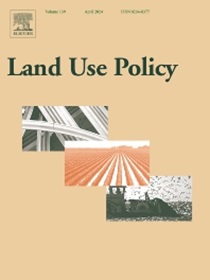城市局地气候带热缓解制图研究进展:系统综述
IF 6
1区 社会学
Q1 ENVIRONMENTAL STUDIES
引用次数: 0
摘要
局部气候带(LCZ)分类是解决城市化对环境影响的重要工具,特别是在缓解城市热岛(UHI)和管理温度变化方面。采用pssar方法对2018年至2023年Scopus和Web of Science数据库中的126篇出版物进行了系统评价。评估了近年来在景观分类方面的研究进展,重点是越来越多地使用遥感和地理信息系统(GIS)进行景观分类。研究结果表明,天空景观因子(SVF)和粗糙度元素高度(HRE)等关键城市几何参数对于分析太阳辐射和温度控制至关重要。该综述强调,17.64 %的研究集中在高收入国家,强调需要更多来自拉丁美洲城市和其他新兴经济体的代表。尽管数据有限,15.68 %的研究分析了不透水性和渗透率。代表性不足地区的研究空白强调了纳入林地和草地比例(PWG)、植被覆盖度(FVC)、归一化植被指数(NDVI)、建成区(BA)、容积率(FAR)和归一化建筑指数(NDBI)等附加参数来增强LCZ分类框架的必要性。本研究强调了遥感和地理信息系统在提高地方尺度城市热岛研究精度方面的重要作用。将LCZ制图纳入城市规划对于管理景观异质性和促进可持续发展至关重要。扩大对开放城市数据集的访问和采用创新的数字方法将进一步推动全球LCZ研究。本文章由计算机程序翻译,如有差异,请以英文原文为准。
Advances in urban mapping of local climate zones for heat mitigation: A systematic review
Local Climate Zones (LCZ) classification is an essential tool in addressing the environmental impacts of urbanization, particularly in mitigating Urban Heat Islands (UHI) and managing temperature variations. A systematic review was conducted using PSALSAR methodology, analyzing 126 publications from Scopus and Web of Science databases from 2018 to 2023. Recent advances in LCZ research were evaluated, with a focus on the increasing use of remote sensing and Geographic Information Systems (GIS) for landscape classification. The findings indicate that key urban geometry parameters, such as the Sky View Factor (SVF) and Height of Roughness Elements (HRE), are crucial for analyzing solar radiation and temperature control. The review highlights that 17.64 % of the studies are concentrated in high-income countries, underscoring the need for more representation from Latin American cities and other emerging economies. Despite data limitations, 15.68 % of the studies analyzed imperviousness and permeability. Research gaps in underrepresented regions emphasize the necessity of incorporating additional parameters such as Proportion of Woodland and Grass (PWG), Fraction of Vegetation Coverage (FVC), Normalized Difference Vegetation Index (NDVI), Built-up Area (BA), Floor Area Ratio (FAR), and Normalized Difference Building Index (NDBI) to enhance the LCZ classification framework. This research emphasizes the significant role of remote sensing and GIS in improving accuracy in local scale UHI studies. Integrating LCZ mapping into urban planning is essential for managing landscape heterogeneity and fostering sustainable development. Expanding access to open urban datasets and adopting innovative digital methods will further advance LCZ research globally.
求助全文
通过发布文献求助,成功后即可免费获取论文全文。
去求助
来源期刊

Land Use Policy
ENVIRONMENTAL STUDIES-
CiteScore
13.70
自引率
8.50%
发文量
553
期刊介绍:
Land Use Policy is an international and interdisciplinary journal concerned with the social, economic, political, legal, physical and planning aspects of urban and rural land use.
Land Use Policy examines issues in geography, agriculture, forestry, irrigation, environmental conservation, housing, urban development and transport in both developed and developing countries through major refereed articles and shorter viewpoint pieces.
 求助内容:
求助内容: 应助结果提醒方式:
应助结果提醒方式:


